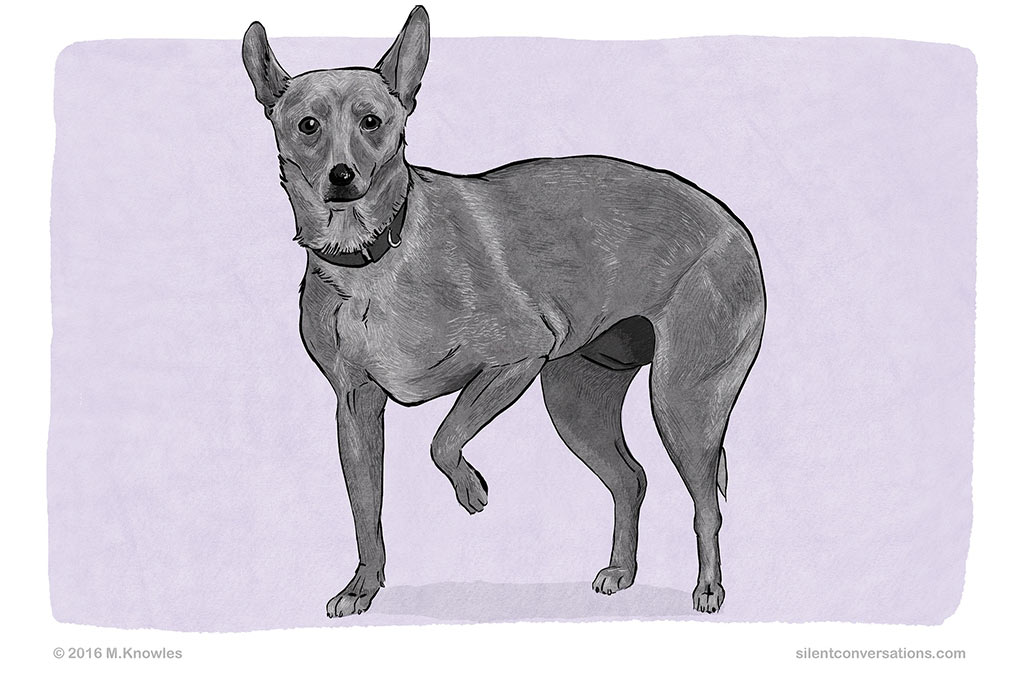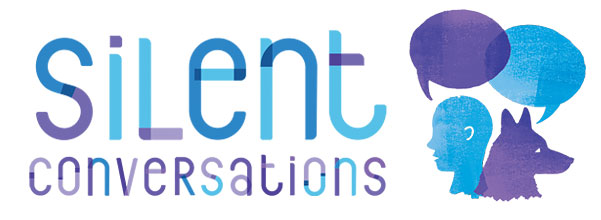
Paw Lift – Dog Body Language
A paw lift is when one paw is lifted ever so slightly off the ground. It is different to a paw lift when stalking or hunting, which can be quite rigid; this paw lift can seem a bit more tentative. Depending on the rest of the dog’s body language and context, it is generally used when the dog may be feeling conflicted, anxious or anticipating something.
Here are a few examples of situations where a dog may offer a paw lift:
- This was an observation of a dog that had not been socialized much with people. She was not comfortable approaching and was quite fearful. She would create space; her body was low and hunched over, her tail curled under, and her mouth was closed. Tension was seen in her face muscles and her eyes were quite wide. Her head was turned away and her ears were scanning and listening for sound, alternating between being back and then to the side. Along with the body language, she lifted her paw a few times while standing in this tense pose. The paw lift, along with all the other body language, paints a picture of a dog that is fearful and feeling very uncertain in this situation.
- One dog is approached by another dog. The approaching dog walks into the other dog’s space, standing quite close, with a stiff square body, head held high and ears slightly forward; his whole body seems stiff when moving, and he gives a bit of direct eye contact. This approach is a bit too direct and it seems to unsettle the other dog; it is difficult to walk away as she tries to keep her eye on the dog that has approached and taken space so quickly. She does a slight head turn and a paw lift. She is showing she is uncomfortable with this interaction.
- A person is asking a dog to sit. This is taking a while and the dog does not seem to be responding. The person tries to lure the dog into a sitting position, moving his hand closer to the dog’s head. The dog takes a step back and does a paw lift. The dog may feel a bit of pressure and be uncomfortable with the person’s hand moving into her space along with this unknown request to sit.
- A dog is sitting and observing his guardian, who might be preparing something. As the dog watches with wide eyes and ears forward, he does a paw lift. This dog may be anticipating something and showing a bit of discourse in trying to figure something out.
- There is a loud, sudden noise. The dog freezes, his eyes widen, his ears go up and are alert, and he does a paw lift. The sudden noise was unsettling; he shows his discomfort by doing a paw lift whilst he tries to figure out what the sound was.
These are just a few examples; there may be many more. Start observing to see if you can notice any paw lifts in different contexts. As discussed below, interpretations such as the above examples should not be attempted without careful observation and consideration of all aspects of the situation.
What is meant by stress?
When I mention stress, this does not necessarily imply negative emotion. I mean stress in the physiological sense. So certain body language signals can mean the dog is feeling some sort of emotional discourse. This discourse could range from positive to negative emotion. Both excitement and fear could have similar effects on the body, with various hormones being released and activating the sympathetic nervous system. The dog may be feeling uncomfortable/fearful or it could also be excited about something. When analyzing stress in body language, it is worth noting the frequency and intensity of the various body language signals.
A few notes to consider when observing dog body language:
Observation before interpretation
Interpretations should be offered only once you have observed the complete interaction and taken note of the wider picture. To offer an unbiased interpretation of the body language, observe and take note of the situation, taking into account the dog’s whole body, the body language signals, and environment first before offering an interpretation. List all the body language you see in the order that it occurs; try to be as descriptive as possible without adding any emotional language. For instance, saying a dog looks happy is not descriptive and would be seen as an interpretation rather than an observation.
You could, however, list what you observe: ears to the side, eyes almond shaped, slight shortening of the eye, mouth open, long lips, tongue out, body moving loosely, body facing side-on, tail wagging at a slow even pace at body level.
From the observation, I could interpret that the dog seems relaxed or comfortable. I still prefer to say relaxed rather than happy, as I feel you will truly never know exactly what the dog may be feeling on the inside emotionally. It is quite likely the dog may be feeling happy, but I prefer to comment on how the dog is behaving in response to the situation rather than presuming internal emotional states.
The importance of viewing body language within context
Interpretations can vary depending on the context. It is possible for certain body language to be used in different contexts and have subtle differences in meaning within those contexts. Individual body language signals should not be observed in isolation; the wider picture should be considered. Take note of what the dog’s body as a whole is saying. Keep in mind each dog is an individual with varying skills and experiences. What may be typical for one individual may not be for another. In order to observe body language in context, consider the following: the situation, body language signals, the body language expressed by all parts of the dog’s body, environment, and individuals involved. It is worth noting how the body language changes with feedback from the environment or the other individuals interacting.

Martha Knowles
Author
My vision is to create a community of dog guardians who share their observations and interpretations of their dogs’ silent conversations. Hopefully, these experiences and stories will provide some insight into dog communication, which is often overlooked by the untrained eye because it is unfamiliar to humans. We are accustomed to communicating mainly with sound, so we are not attuned to the silent subtle gestures and body language used by dogs to communicate. If you take the time to observe, you will start to see these 'silent conversations' going on around you. My dream is for dog communication to become common knowledge with all dog guardians and as many people as possible. Surprisingly, there are still some professionals working in various dog-related careers who are uneducated about dog body language. Greater awareness of how dogs communicate will help to provide better understanding and improve the mutual relationship between dogs and humans. This will promote safer interactions between our two species and hopefully remove some of the expectations placed on dogs within human society. I would like dog guardians to feel empowered with their knowledge of dog communication so that they can be their dogs’ advocates and stand up for themselves and their dogs when it really matters.
